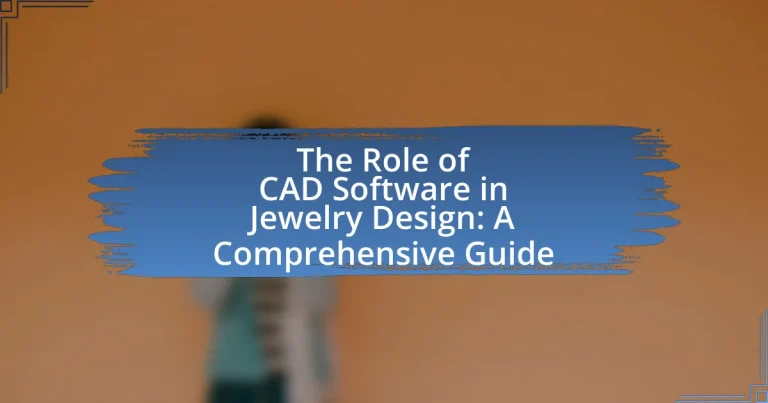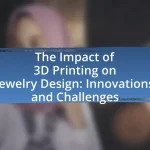The article focuses on the pivotal role of CAD (Computer-Aided Design) software in jewelry design, highlighting its ability to create precise 3D models that enhance creativity and streamline the design process. It discusses how CAD technology transforms traditional design methods, improves accuracy, and reduces production time and costs. Key features of CAD software, such as 3D modeling, parametric design, and rendering capabilities, are examined, along with the various types of CAD software available for jewelry designers. Additionally, the article addresses best practices for using CAD software effectively, common challenges faced by designers, and resources for improving CAD skills.

What is the Role of CAD Software in Jewelry Design?
CAD software plays a crucial role in jewelry design by enabling designers to create precise and intricate 3D models of their concepts. This technology allows for detailed visualization, which enhances creativity and facilitates modifications before production. Additionally, CAD software streamlines the design process, reducing the time and cost associated with traditional methods. According to a study published in the Journal of Design and Technology Education, the use of CAD in jewelry design has been shown to improve accuracy by up to 30%, demonstrating its effectiveness in producing high-quality designs.
How does CAD software transform traditional jewelry design processes?
CAD software transforms traditional jewelry design processes by enabling precise 3D modeling and visualization, which enhances creativity and efficiency. Traditional methods often rely on hand-drawing and physical prototypes, which can be time-consuming and limit design possibilities. In contrast, CAD software allows designers to create intricate designs digitally, facilitating rapid modifications and iterations. This technology also streamlines the production process by generating accurate specifications for manufacturing, reducing errors and material waste. According to a study published in the Journal of Jewelry Technology, the adoption of CAD in jewelry design has led to a 30% reduction in production time and a 25% decrease in material costs, demonstrating its significant impact on the industry.
What are the key features of CAD software that benefit jewelry designers?
The key features of CAD software that benefit jewelry designers include 3D modeling, parametric design, and rendering capabilities. 3D modeling allows designers to create intricate and precise representations of jewelry pieces, facilitating detailed visualization and modifications. Parametric design enables designers to easily adjust dimensions and features, ensuring that changes can be made efficiently without starting from scratch. Rendering capabilities provide high-quality visualizations, helping designers present their concepts to clients effectively. These features streamline the design process, enhance creativity, and improve communication, ultimately leading to more successful jewelry designs.
How does CAD software enhance creativity in jewelry design?
CAD software enhances creativity in jewelry design by providing designers with advanced tools for visualization and manipulation of intricate designs. This software allows for rapid prototyping, enabling designers to experiment with various shapes, materials, and textures without the constraints of traditional methods. For instance, CAD software can generate 3D models that can be easily modified, allowing for immediate feedback and iteration, which fosters innovative ideas. Additionally, features like parametric design enable designers to create complex geometries that would be difficult to achieve manually, thus expanding the creative possibilities in jewelry design.
Why is CAD software essential for modern jewelry designers?
CAD software is essential for modern jewelry designers because it allows for precise design, visualization, and modification of intricate jewelry pieces. This technology enables designers to create detailed 3D models, which can be easily altered to meet specific client requirements or design preferences. Furthermore, CAD software streamlines the production process by generating accurate specifications for manufacturing, reducing errors and material waste. According to a study published in the Journal of Design and Technology Education, the use of CAD in jewelry design has been shown to increase efficiency by up to 30%, demonstrating its critical role in contemporary design practices.
What advantages does CAD software provide over manual design methods?
CAD software offers significant advantages over manual design methods, including enhanced precision, efficiency, and the ability to easily modify designs. Unlike manual techniques, which can introduce human error and inconsistencies, CAD software utilizes algorithms to ensure accurate measurements and proportions, resulting in higher-quality designs. Additionally, CAD allows designers to quickly iterate and experiment with various design elements, reducing the time spent on revisions. For instance, a study by the National Institute of Standards and Technology found that CAD can improve design productivity by up to 50% compared to traditional methods. This efficiency not only accelerates the design process but also enables designers to focus on creativity rather than technical limitations.
How does CAD software improve accuracy and precision in jewelry design?
CAD software enhances accuracy and precision in jewelry design by allowing designers to create detailed 3D models that can be manipulated and adjusted with high precision. This software enables the use of exact measurements and geometric calculations, ensuring that every aspect of the design adheres to specified dimensions. For instance, CAD systems can produce designs with tolerances as tight as 0.01 mm, which is crucial for intricate jewelry pieces. Additionally, the ability to visualize and simulate the final product before manufacturing reduces errors and discrepancies, leading to a more accurate representation of the intended design. This capability is supported by the fact that CAD software often includes tools for automated error checking and optimization, further enhancing the overall precision of the jewelry design process.

What are the Different Types of CAD Software Used in Jewelry Design?
The different types of CAD software used in jewelry design include RhinoGold, MatrixGold, 3Design, and JewelCAD. RhinoGold is known for its versatility and user-friendly interface, making it popular among jewelers for creating intricate designs. MatrixGold offers advanced tools for parametric design, allowing for customization and efficiency in the design process. 3Design is recognized for its real-time rendering capabilities, enabling designers to visualize their creations effectively. JewelCAD is favored for its intuitive design features and ease of use, catering to both beginners and experienced designers. These software options provide various functionalities that enhance the jewelry design process, making them essential tools in the industry.
What are the most popular CAD software options for jewelry design?
The most popular CAD software options for jewelry design include RhinoGold, MatrixGold, and 3Design. RhinoGold is widely recognized for its versatility and user-friendly interface, making it a favorite among jewelry designers. MatrixGold offers advanced features tailored specifically for the jewelry industry, allowing for intricate designs and easy modifications. 3Design is known for its powerful rendering capabilities and parametric design tools, which enhance the creative process. These software options are frequently used in the jewelry design community due to their specialized tools and functionalities that cater to the unique needs of jewelry creation.
How do different CAD software programs cater to various design needs?
Different CAD software programs cater to various design needs by offering specialized tools and features tailored to specific industries and design requirements. For instance, software like Rhino is favored in jewelry design for its flexibility and advanced surface modeling capabilities, allowing designers to create intricate and detailed pieces. In contrast, AutoCAD is widely used in architectural design due to its precision and extensive drafting tools, which are essential for creating accurate building plans. Additionally, programs like SolidWorks provide robust parametric modeling features that are beneficial for engineering applications, enabling designers to easily modify and optimize their designs. Each software’s unique functionalities address the distinct challenges faced in different design fields, ensuring that users can effectively meet their specific project goals.
What are the pricing models for popular CAD software in jewelry design?
Popular CAD software in jewelry design typically employs three main pricing models: subscription-based, perpetual licensing, and pay-per-use. Subscription-based models, such as those offered by RhinoGold and MatrixGold, charge users a recurring fee, often monthly or annually, providing access to updates and support. Perpetual licensing, seen in software like SolidWorks, requires a one-time payment for indefinite use, though users may need to pay for updates separately. Pay-per-use models, utilized by some cloud-based platforms, charge users based on the amount of time or resources consumed, allowing for flexibility in costs. These pricing structures cater to different user needs and budgets, making CAD software accessible to a wide range of jewelry designers.
How do jewelry designers choose the right CAD software?
Jewelry designers choose the right CAD software by evaluating features that align with their design needs, such as 3D modeling capabilities, rendering quality, and ease of use. Designers often prioritize software that offers specialized tools for jewelry design, like gemstone setting and metalworking simulations. Additionally, they consider compatibility with manufacturing processes and the ability to produce files for 3D printing or CNC machining. Research indicates that user reviews and industry recommendations play a significant role in this decision-making process, as designers seek software that enhances productivity and creativity while minimizing technical challenges.
What factors should designers consider when selecting CAD software?
Designers should consider compatibility, functionality, user interface, cost, and support when selecting CAD software. Compatibility ensures the software integrates well with existing tools and file formats, which is crucial for seamless workflows in jewelry design. Functionality refers to the specific features offered, such as 3D modeling capabilities and rendering options, which directly impact the design process. A user-friendly interface enhances productivity by reducing the learning curve, allowing designers to focus on creativity rather than software navigation. Cost is a significant factor, as it affects budget constraints; designers must evaluate whether the software provides value for its price. Lastly, reliable customer support is essential for troubleshooting and maximizing the software’s potential, ensuring designers can resolve issues promptly and maintain their workflow.
How can designers evaluate the usability of CAD software?
Designers can evaluate the usability of CAD software by conducting user testing, analyzing user feedback, and assessing task completion rates. User testing involves observing how designers interact with the software to identify pain points and areas for improvement. Analyzing user feedback through surveys or interviews provides insights into user satisfaction and specific usability issues. Additionally, assessing task completion rates helps quantify how efficiently users can accomplish design tasks, which is critical for determining the software’s effectiveness. Studies have shown that usability testing can lead to a 50% increase in user satisfaction and productivity when software is optimized based on user input.

What are the Best Practices for Using CAD Software in Jewelry Design?
The best practices for using CAD software in jewelry design include mastering the software’s tools, maintaining a clear design workflow, and regularly saving work. Mastering tools such as modeling, rendering, and simulation features allows designers to create intricate and precise designs. A clear workflow, which involves sketching ideas, creating 3D models, and refining designs, enhances efficiency and reduces errors. Regularly saving work prevents data loss and allows for easy revisions. These practices are essential for achieving high-quality designs and optimizing the design process in jewelry creation.
How can jewelry designers maximize the benefits of CAD software?
Jewelry designers can maximize the benefits of CAD software by utilizing its advanced modeling capabilities to create intricate designs with precision. By leveraging features such as 3D visualization, designers can experiment with various styles and materials, allowing for rapid prototyping and adjustments before production. This approach not only reduces material waste but also shortens the design cycle, enabling designers to bring their creations to market faster. Furthermore, CAD software often includes tools for generating technical specifications and production-ready files, ensuring that designs are manufacturable and meet industry standards. This integration of design and production processes enhances overall efficiency and accuracy in jewelry creation.
What techniques can enhance the efficiency of using CAD software?
Techniques that can enhance the efficiency of using CAD software include utilizing keyboard shortcuts, employing templates, and integrating parametric design features. Keyboard shortcuts streamline workflows by reducing the time spent navigating menus, as studies show that users can increase productivity by up to 30% when using shortcuts effectively. Templates allow designers to maintain consistency and save time on repetitive tasks, while parametric design features enable quick modifications to designs, significantly speeding up the iteration process. These techniques collectively improve the overall efficiency and effectiveness of CAD software in jewelry design.
How can designers stay updated with the latest CAD software features?
Designers can stay updated with the latest CAD software features by regularly participating in industry webinars, following software release notes, and engaging with online communities. These activities provide insights into new functionalities and best practices. For instance, many CAD software companies, such as Autodesk and Rhino, frequently host webinars that showcase new features and updates. Additionally, subscribing to newsletters from these companies ensures that designers receive timely information about software enhancements. Engaging in forums like Reddit or specialized CAD groups on social media platforms allows designers to share experiences and learn from peers about the latest tools and techniques.
What common challenges do designers face when using CAD software?
Designers commonly face challenges such as a steep learning curve, software compatibility issues, and performance limitations when using CAD software. The complexity of CAD tools often requires extensive training, which can hinder productivity, especially for new users. Additionally, designers may encounter difficulties when integrating CAD software with other design tools or platforms, leading to inefficiencies in workflow. Performance limitations, such as slow rendering times or crashes with complex designs, can further disrupt the design process. These challenges are well-documented in industry reports, highlighting the need for ongoing training and software optimization to enhance user experience and efficiency in jewelry design.
How can designers troubleshoot common issues in CAD software?
Designers can troubleshoot common issues in CAD software by systematically identifying the problem, consulting the software’s help resources, and utilizing community forums for solutions. For instance, if a designer encounters rendering issues, they should first check the software settings and graphics card compatibility, as many CAD programs require specific hardware configurations to function optimally. Additionally, accessing the software’s official documentation can provide insights into known issues and fixes. Community forums, such as those on platforms like Reddit or specialized CAD forums, often contain user-generated solutions that can address unique problems encountered by designers. This approach is effective because it combines technical resources with community knowledge, ensuring a comprehensive troubleshooting process.
What resources are available for learning CAD software effectively?
Online courses, tutorials, and books are essential resources for learning CAD software effectively. Platforms like Coursera, Udemy, and LinkedIn Learning offer structured courses that cover various CAD software, including AutoCAD and Rhino, often featuring hands-on projects. Additionally, YouTube hosts numerous free tutorials that provide visual guidance on specific features and techniques. Books such as “Mastering AutoCAD” by George Omura and “Rhino for Jewelry” by Dana Buscaglia serve as comprehensive references for in-depth learning. These resources collectively enhance understanding and proficiency in CAD software, making them valuable for anyone interested in jewelry design.
What tips can help jewelry designers improve their CAD skills?
Jewelry designers can improve their CAD skills by practicing regularly, utilizing online tutorials, and engaging with CAD communities. Regular practice helps reinforce learned techniques and enhances familiarity with software tools. Online tutorials provide step-by-step guidance on specific features and advanced techniques, allowing designers to learn at their own pace. Engaging with CAD communities, such as forums or social media groups, facilitates knowledge sharing and feedback, which can lead to improved skills and innovative design approaches.


